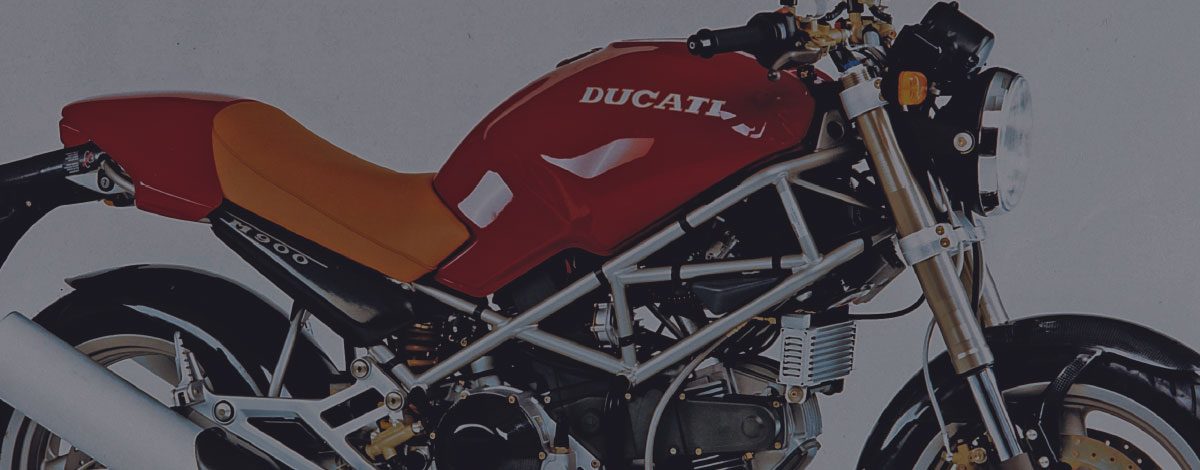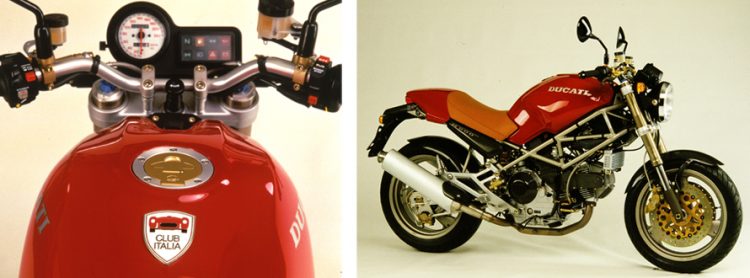

“It looks like an optimal piece of marketing intuition, a carefully constructed object of desire. But the Monster goes far beyond marketing. It’s a reflection of what was happening in society back then. An era in which people wanted clarity. We’d just come out of the 80s, and industrialised countries had gorged themselves on every excess possible. We needed to get back to basics, not just a banal simplicity though, but one rich in content”.
Miguel Galluzzi
There could not have been a better bike for Club Italia’s first foray into the two-wheeled world. Quite rightly, the Club went for the most iconic, revolutionary motorcycle of the 1990s, the Ducati Monster, the bike that opened up an entirely new ‘Naked’ segment. The first model was the brainchild of brilliant Argentine designer Miguel Galluzzi. Back then, Ducati was still owned by the Castiglioni brothers and that meant it was part of the Cagiva Group.
“All the sketches coming out of the style centres at the time depicted bikes with fairings… there was plastic everywhere”, says Galluzzi, a man as whimsical as his creations. “Then, one day, I came across a newspaper clipping with a photo of a Ducati 750 F1 completely stripped of the fairing. It was the 1988 tricolour version, and I said to myself: I’d love a bike like that. That’s my kind of machine, free from all the plastic. I immediately made a sketch and when I joined Cagiva, in 1989, I showed them my drawings and said: We simply have to build this bike. Two years went by, mostly spent designing scooters of every type and colour. Then, in the summer of 1991, I took an 851 frame, a 900 engine, put the pieces together and built the prototype. I recall people at Ducati telling me the bike would come to nothing. Some said ‘Well… is that it? Aren’t you missing some parts?’ I named it Monster because my children, who were young at the time, used to play with collectible rubber puppets called Monsters. Ducati consulted a specialised agency – man, they could really write some weird stuff – and they had not one good word to say about it. Some people even came up with a story that the bike was called Monster because it was ugly, but that’s simply insane. She’s gorgeous”.
Yes, the Monster was undoubtedly the right bike to become the first Club Italia bike.
The idea of extending the Club philosophy to motorcycling came about naturally. Club Italia has always been a standard-bearer for Italian cars and since 1995 it has extended the same courtesy to motorcycles. That year, in fact, Ducati produced a customized (just 36 bikes) Monster 900, with Piero Ferrari putting in a significant contribution.
Today, the Bologna-based bike manufacturer’s Monster enjoys cult status as the bike of the 1990s. Its appearance heralded a new, industry-wide styling philosophy. Today, it remains the king of the naked bike world, as popular as ever in Europe and America. In addition to the brand’s super-sophisticated technical solutions – the L-twin engine, the Trellis frame and the desmodromic timing – the Ducati M900 Club Italia sports an exclusive livery and cutting-edge components that were developed in competition.
TECHNICAL SPECIFICATIONS
| engine | L-twin |
| timing | desmodromic, 2 valves per cylinder |
| cooling | air-cooled |
| displacement | 904 cc |
| bore x stroke | 92 x 68 mm |
| power | 71 hp |
| torque | 74 Nm |
| fuelling | carburettors |
| exhaust | 2-1-2 system |
| gearbox | 6-gear |
| clutch | multi-disc |
| front suspension | upside-down Showa fork |
| rear suspension | progressive with Boge monoshock |
| dry weight | 185 kg |
| braking system | Brembo, dual front disc, rear disc |
| speed | 208 kph |

